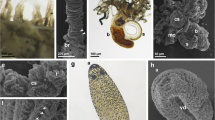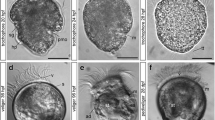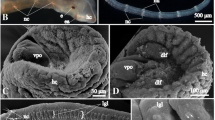Abstract
The planula larva of the hydroid Clava multicornis (Forskål, 1775) has a complex nervous system, characterized by the presence of distinct, anteriorly concentrated peptidergic populations of amidated neurons, presumably involved in the detection of environmental stimuli and metamorphic signals. Differently from other hydrozoan larvae in C. multicornis planulae GLW-positive cells with putative sensory role have a peculiar dome-shaped forefront organization, followed by a belt of RF-positive nerve cells. By immunohistochemistry, we investigated the transformation of the peptidergic (GLW-amide and RF-amide) larval neuroanatomy at different stages of metamorphosis and the subsequent development of the primary polyp nervous system. By terminal transferase-mediated dUTP nick end-labeling assay, apoptotic nuclei were first identified in the anterior pole of the settled larva, in the same region occupied by GLW-amide positive putative sensory cells. In primary polyps, GLW-amide positive signals first encircled the hypostome area, later extending downwards along the polyp column or upwards over the hypostome dome, whereas RF-amide positive sensory cells initially appeared at the tentacles base to later extend in the tentacles and the polyp column. In spite of the possession of distinct neuroanatomies, different cnidarian planulae may share common developmental mechanisms underlying metamorphosis, including apoptosis and de novo differentiation. Our data confirm the hypothesis that the developmental dynamics of tissue rearrangements may be not uniform across different taxa.




Similar content being viewed by others
References
Anderson PAV, Thompson LF, Moneypenny CG (2004) Evidence for a common pattern of peptidergic innervation of cnidocytes. Biol Bull 207:141–146
Bouillon J (1983) Sur le cycle biologique de Eirene hexanemalis (Goette, 1886) (Eirenidae, Leptomédusae, Hydrozoa, Cnidaria). Cah Biol Mar 24:421–427
Brumwell GB, Martin VJ (2002) Immunocytochemically defined populations of neurons progressively increase in size through embryogenesis of Hydra vulgaris. Biol Bull 203:70–79
Dockray DJ (2004) The expanding family of -RF-amide peptides and their effects on feeding behaviour. Exp Physiol 89:229–235
Ermak TH, Eakin RM (1976) Fine structure of the cerebral and pygidial ocelli in Chone ecaudata (Polychaeta: Sabellidae). J Ultrastruct Res 54:243–260
Grasso LC, Negri AP, Fôret S, Saint R, Hayward DC, Miller DJ, Ball EE (2011) The biology of coral metamorphosis: molecular responses of larvae to inducers of settlement and metamorphosis. Dev Biol 353:411–419
Grimmelikhuijzen CJP, Williamson M, Hansen GN (2002) Neuropeptides in Cnidarians. Can J Zool 80:1690–1702
Hamaguchi-Hamada K, Fujisawa Y, Koizumi O, Muneoka Y, Hamada S (2009) Immunohistochemical evidence for the existence of novel mammalian neuropeptides related to the Hydra GLW-amide neuropeptide family. Cell Tissue Res 337:15–25
Hand C, Uhlinger KR (1992) The culture, sexual and asexual reproduction, and growth of the sea-anemone Nematostella vectensis. Biol Bull 182:169–176
Husson SJ, Clynen E, Baggermann G, DeLoof A, Schoofs L (2005) Discovering neuropeptides in Caenorhabditis elegans by two-dimensional liquid chromatography and mass spectrometry. Biochem Biophys Res Commun 335:76–86
Iwao K, Fujisawa T, Hatta M (2002) A cnidarian neuropeptide of the GLW-amide family induces metamorphosis of reef-building corals in the genus Acropora. Coral Reefs 21:127–129
Koizumi O, Itazawa M, Mizumoto H, Minobe S, Javois LC, Grimmelikhuijzen CJ, Bode HR (1992) Nerve ring of the hypostome in hydra. I. Its structure, development, and maintenance. J Comp Neurol 326:7–21
Leitz T (1997) Induction of settlement and metamorphosis of Cnidarian larvae: signal and signal transduction. Invertebr Reprod Dev 31:109–122
Leitz T (1998) Metamorphosin A and related peptides: a novel family of neuropeptides with morphogenetic activity. Ann NY Acad Sci 839:105–110
Leitz T, Lay M (1995) Metamorphosin-A is a neuropeptide. Rouxs Arch Dev Biol 204:276–279
Leitz T, Morand K, Mann M (1994) Metamorphosin A, a novel peptide controlling development of the lower metazoan Hydractinia echinata. Dev Biol 163:440–446
Martin VJ (2000) Reorganization of the nervous system during metamorphosis of a hydrozoan planula. Invertebr Biol 119:243–253
Mazia D, Schatten G, Sale W (1975) Adhesion of cells to surfaces coated with polylysine. Applications to electron microscopy. J Cell Biol 66:198–200
Muller WA, Leitz T (2002) Metamorphosis in the Cnidaria. Can J Zool 80:1755–1771
Orlov D (1996) Observations on the settling behaviour of planulae of Clava multicornis Forskål (Hydroidea, Athecata). In: Piraino S, Boero F, Bouillon J, Cornelius PFS, Gili JM (eds) Advances in hydrozoan biology. Sci Mar 60:121–128
Pernet V, Anctil M, Grimmelikhuijzen JP (2004) Antho-RF-amide-containing neurons in the primitive nervous system of the anthozoan Renilla koellikeri. J Comp Neurol 472:208–220
Piperno G, Fuller MT (1985) Monoclonal antibodies specific for an acetylated form of α-tubulin recognize the antigen in cilia and flagella from a variety of organisms. J Cell Biol 101:2085–2094
Piraino S, Boero F, Aeschbach B, Schmid V (1996) Reversing the life cycle: medusae transforming into polyps and cell transdifferentiation in Turritopsis nutricula (Cnidaria, Hydrozoa). Biol Bull 190:302–312
Piraino S, De Vito D, Schmich J, Bouillon J, Boero F (2004) Reverse development in Cnidaria. Can J Zool 82:1748–1754
Piraino S, Zega G, Di Benedetto C, Leone A, Dell’Anna A, Pennati R, Candia Carnevali D, Schmid V, Reichert H (2011) Complex neural architecture in the diploblastic larva of Clava multicornis (Hydrozoa, Cnidaria). J Comp Neurol 519:1931–1951
Plickert G, Schneider B (2004) Neuropeptides and photic behavior in Cnidaria. Hydrobiologia 530:49–57
Plickert G, Schetter E, Verhey-Van-Wijk N, Schlossherr J, Steinbuchel M, Gajewski M (2003) The role of alpha-amidated neuropeptides in hydroid development—LWamides and metamorphosis in Hydractinia echinata. Int J Dev Biol 47:439–450
Price DA, Greenberg MJ (1977) Structure of a molluscan cardioexcitatory peptide. Science 197:670–671
Schmich J, Trepel S, Leitz T (1998) The role of GLW-amides in metamorphosis of Hydractinia echinata. Dev Genes Evol 208:267–273
Schmich J, Kraus Y, De Vito D, Graziussi D, Boero F, Piraino S (2007) Induction of reverse development in two marine hydrozoans. Int J Dev Biol 51:45–46
Schmid V (1992) Transdifferentiation in medusae. Int RevCytol 142:213–261
Seipp S, Schmich J, Leitz T (2001) Morphogenesis of Cnidaria: programmed cell death during metamorphosis of Hydractinia echinata. Zoology (Jena) 103:13
Seipp S, Schmich J, Kehrwald T, Leitz T (2007) Metamorphosis of Hydractinia echinata-natural versus artificial induction and developmental plasticity. Dev Genes Evol 217:385–394
Seipp S, Schmich J, Will B, Shetter E, Plickert G, Leitz T (2010) Neuronal cell death during metamorphosis of Hydractinia echinata (Cnidaria, Hydrozoa). Invertebr Neurosci 10:77–91
Yuan D, Nakanishi N, Jacobs DK, Hartenstein V (2008) Embryonic development and metamorphosis of the scyphozoan Aurelia. Dev Genes Evol 218:525–539
Acknowledgments
This study was funded by PRIN Italian Ministry for research and education (grant number 2007-5WCPWM) and by the ASSEMBLE project (remote access Station Biologique de Roscoff, and on-site access at the Sven Lovén Centre for Marine Sciences, Kristineberg). The publication of this paper has been also supported by CONISMA, the Italian National Inter-University Consortium for Marine Sciences. We thank two anonymous reviewers and Dr Andreas Schmidt-Rhaesa for valuable advices.
Author information
Authors and Affiliations
Corresponding author
Additional information
Communicated by A. Schmidt-Rhaesa.
Roberta Pennati and Stefano Piraino equally contributed to this work.
Rights and permissions
About this article
Cite this article
Pennati, R., Dell’Anna, A., Pagliara, P. et al. Neural system reorganization during metamorphosis in the planula larva of Clava multicornis (Hydrozoa, Cnidaria). Zoomorphology 132, 227–237 (2013). https://doi.org/10.1007/s00435-013-0188-1
Received:
Revised:
Accepted:
Published:
Issue Date:
DOI: https://doi.org/10.1007/s00435-013-0188-1




